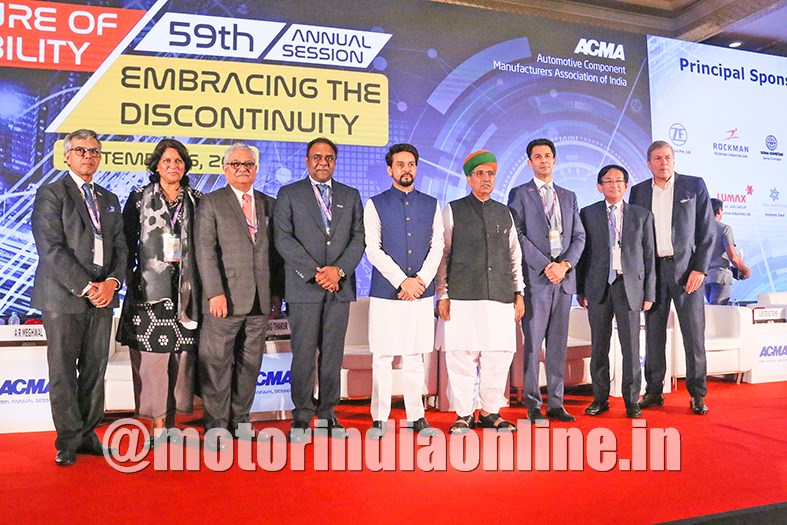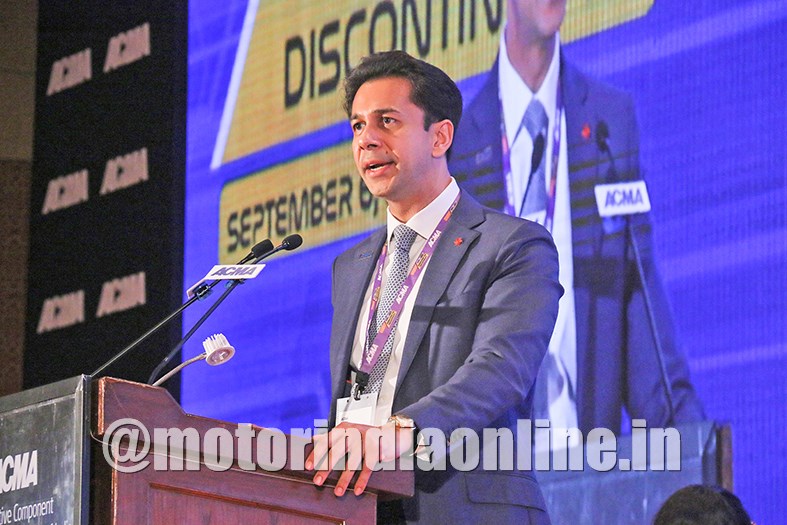At the 59th ACMA annual session, experts from the industry urged suppliers to embrace the various discontinuities and prepare for future opportunities, reports Dhiyanesh Ravichandran

An annual event of discussion organised by Automotive Component Manufacturers Association (ACMA), the apex body of the country’s automotive component industry, under the theme ‘Future of Mobility – Embracing the Discontinuity’ this year at New Delhi saw critical dialogues on identifying disruptions that continue to shape the landscape and defining imperatives for the sector to adapt to and capitalise on emerging opportunities, along with suggesting anchor actions required from other partners, including OEMs and the government.
Discontinuities are disruptions on the curve that drastically alter the way the automotive component industry operates. One among them that is already threatening the industry in an unprecedented way is the prevailing market slowdown, which has replaced the robust growth story of the components’ sector in the past decade. Component sales had grown at 18% in FY18, but FY19 has witnessed a slower growth of 14.5%. In addition, at the annual session of ACMA this year, the industry delineated six other discontinuities on the anvil, which are expected to significantly change the game for both the OEMs and component suppliers.
Ram Venkataramani, President, ACMA, in his welcome address at the session, said that the automotive component industry crossed the $57 billion mark in 2018-19. He added: “The industry currently employs 50 lakh people and contributes 2.3% to the country’s GDP. A significant part of India’s manufacturing sector, we are currently facing an unprecedented slowdown on account of the slump in automotive sales over the last several months, along with the burden of huge investments made for our transition to BS-VI. This has led to a crisis-like situation in our sector, with job losses and restricted investments for the future.”
The session speakers unilaterally agreed that the present slowdown is very different with a myriad range of factors and variables impacting domestic sales, and seems to be lasting longer for a much longer time. They sought a uniform GST rate of 18% for the automotive components sector, as about 30% of the products are still under a higher taxation rate of 28%. Venkataramani also sought better clarity from the government on EV policies, especially for two and three-wheelers. “A stable and technology-agnostic e-mobility policy is the need of the hour to ensure a smooth transition and creation of a strong local supply base,” he noted.
Pointing out that the auto industry has a bright future, Anurag Thakur, Minister of State for Finance, said: “India’s automotive industry is at the forefront in many segments globally. According to estimates, the industry hopes to nearly triple vehicle sales by 2026. This is a good sign for the auto component industry which aims to double its contribution to manufacturing GDP and register a four-fold growth in size and a six-fold growth in exports.” Thakur went on to talk about the various disruptions that are reshaping the auto component industry and encouraged component makers to adapt to the change and make the most of the available opportunities. In his address, Arjun Ram Meghwal, Minister of State for Heavy Industries and Public Enterprises, backed Thakur’s views and reiterated that the government is doing its best to mitigate the auto industry’s woes by coming up with policies and measures to boost sales.
Gearing up for the future
During a panel discussion on the revival of the industry and preparing for the future, Ashok Taneja, Managing Director and CEO, Shriram Pistons and Rings, said that every automotive segment has started plunging down in terms of market sales for the first time over the last three decades, and the reaction to the slowdown is neither swift nor comprehensive this time unlike the previous instances of slowdown. He continued: “A part of the current slowdown is self-inflicted, thanks to the clamorous talks on EVs and wholesome transition to electric mobility in a quick span of time, which has led both the stakeholders and consumers confused.”
He further emphasised on the urgent need to monitor retail sales, as there is no reliable data available at the retail level. “Both OEMs and suppliers relied on their production figures, which gave no clue on subdued market demand and sentiments, and they continued to build up stocks and capacities, which is now a huge problem,” he noted. However, looking beyond the slowdown, Deepak Jain, Managing Director, Lumax Industries, and Vice President, ACMA, said: “With regulations-led-technological changes and business cyclicality making a big impact, the industry needs to prepare itself for the future by relentlessly focusing on changing customer needs and building capabilities.”
The speakers concluded that the automotive component manufacturers must invest and collaborate in joint research and development and risk-sharing, frugal innovation and testing, while also helping on upgrading the skills of Tier I and II suppliers to ensure that they are ready for exports to global markets and embed digital capabilities at par with the industry. They also suggested that the government can play a pivotal role to empower OEMs and suppliers by finding ways to incentivise ‘Make in India’ for EV components to localise production and promote exports, push for developing an entire ecosystem for EV adoption, and create a practical and phased-out EV adoption roadmap.
Deepak Jain elected new ACMA President
Automotive Component Manufacturers Association of India (ACMA), the apex body representing India’s automotive component manufacturing industry, announced the appointment of Deepak Jain, Chairman and Managing Director, Lumax Industries Ltd., as its President and Sunjay Kapur, Chairman, Sona Comstar, as the Vice President for the term 2019-21. The announcement was made at the 59th ACMA Annual Session.
Making the announcements, ACMA Director General Vinnie Mehta said: “An industry veteran and a leading manufacturer of automotive components and systems, Deepak Jain has an in-depth understanding of the industry dynamics. We look forward to his leadership in taking the industry’s agenda forward in these challenging times.”
Accepting the new responsibility, Jain said: “It is a matter of privilege to be appointed to this post. The industry is going through one of the most difficult times ever. Notwithstanding the regulations-led technological changes and business cyclicality, the industry needs to prepare itself for the future. We have therefore created a new pillar at ACMA to focus exclusively on electric vehicles and future mobility. It is indeed an imperative for ACMA to drive change through the entire automotive component manufacturing chain and help its members stay relevant to their customers. I am confident that we will well scale the challenges confronting us with the support of the government and all our stakeholders.”
The discontinuities
There are six discontinuities impacting the automotive component industry, such as:
- A significant acceleration in enforcement of emission and safety standards, bringing India at par with global markets. As a result, the world’s export markets will emerge as a level playing field for Indian players.
- Government and private sector investment thrust on electrification, resulting in new discontinuities out of drastic changes in powertrain and material components, thereby transforming the entire value chain.
- Changing customer preferences and continued rise of shared mobility, creating new revenue pools for automotive component suppliers.
- Growing demand for connected vehicles and change in composition of vehicles with electronics and software contents.
- Consolidation of automotive OEMs, an opportunity for component manufacturers to accelerate modularisation and vendor consolidation, among others.
- Digital and analytics-driven transformation, which is pushing manufacturers to use digital technologies for internal transformation.
